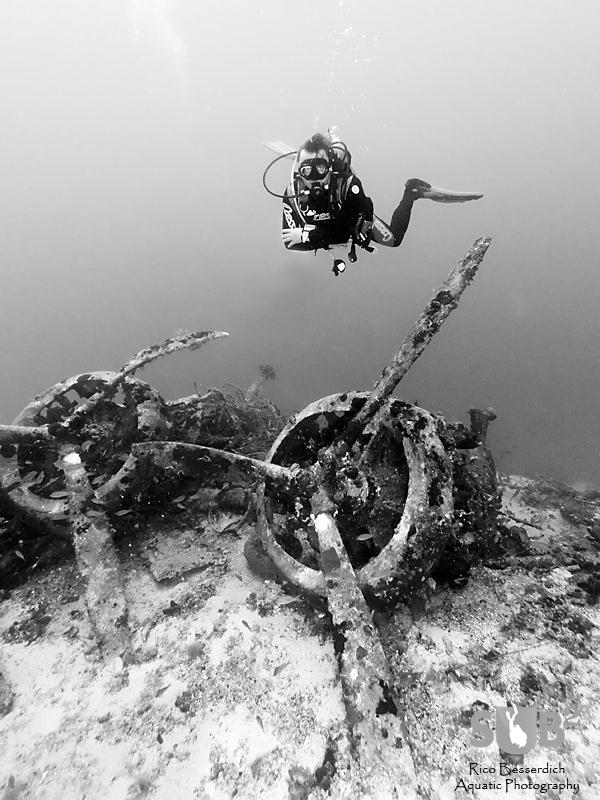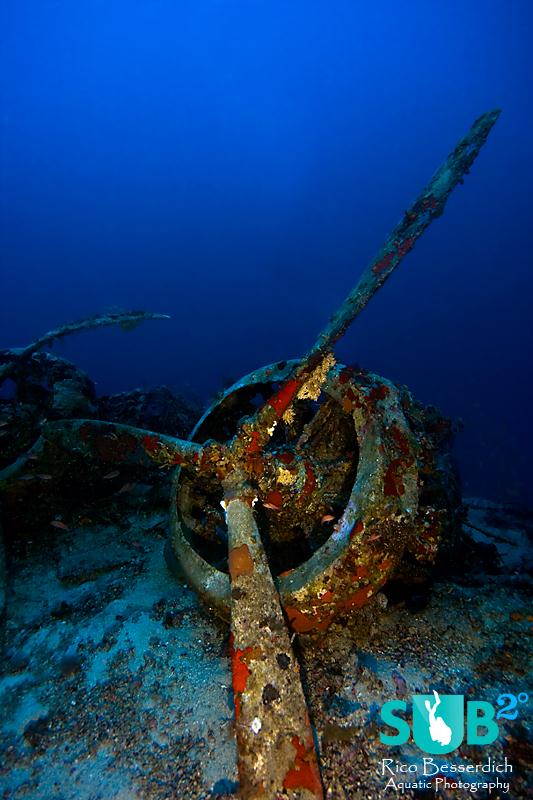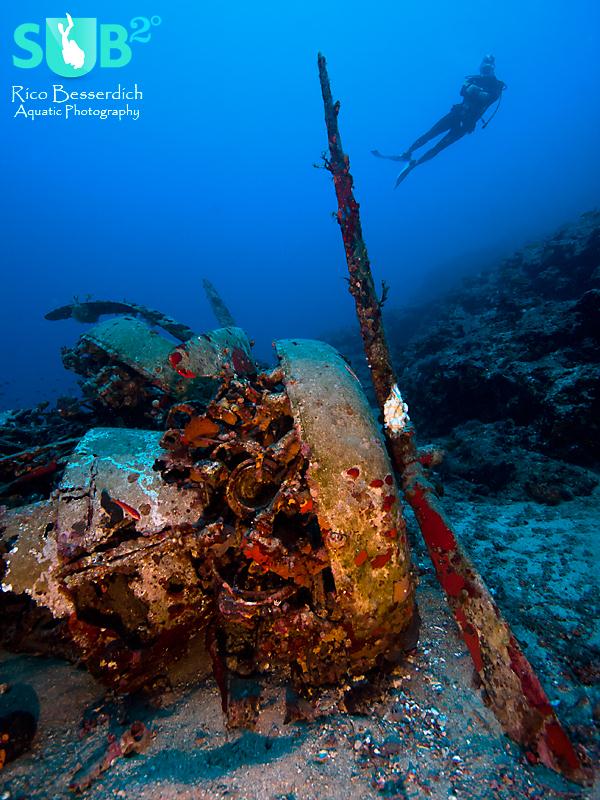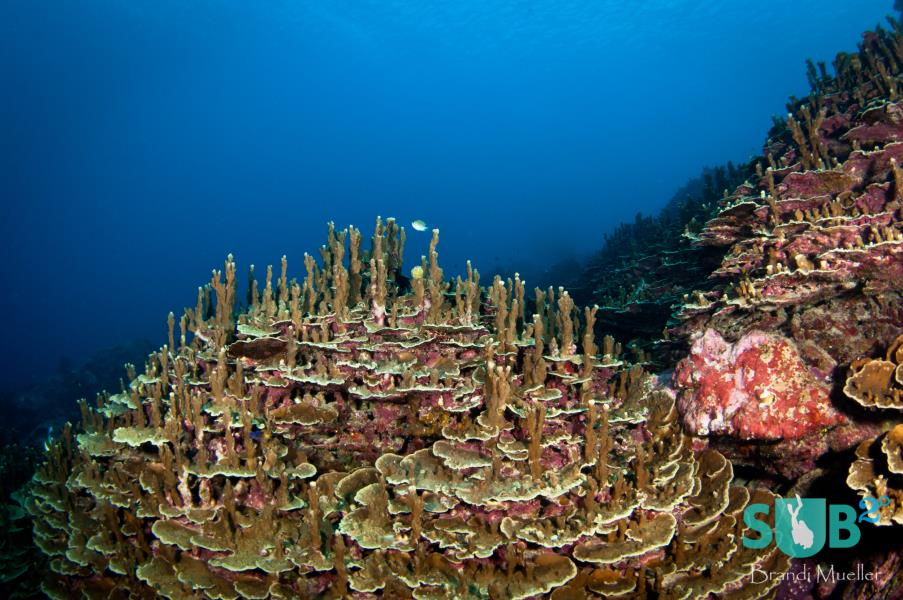-

Deep waters
Diving an airplane wreck in 60 meters depth comes with new challenges to uw photographers. -

Proper prop
Engine & propeller of the Savoia Marchetti SM 79 I "Sparviero" in 60 meter depth. -

Time is up!
Tough task to shoot a wreck in 60 meters. We had only 5 minutes bottom time. Time was up, this is the last shot of the series.
Don't try this at home! An underwater photo shooting at 60 meters depth
Turkey's most popular dive spot is the so called "Flying Fish Reef", located around 5 sea miles away from the small town of Kaş, one of the leading dive destinations of the country. The reef is famous for its rich marine life and its stunning underwater landscape.
Fish, an interesting topography, clear water with visibility up to 40 meters; that all sounds very promising, but there is one more "secret" reason behind this place's popularity: A wreck of an Italian bomber aircraft from the second world war. Depth: 58-71 meters, a dive beyond recreational diving.
A dive to this wreck is a challenge itself. Adding the objective of taking pictures turns it into a serious task. Let me take you to this special place ;-)
But before we hop into the water, here is some short background information about the wreck:
The airplane is a Savoia Marchetti SM 79 I "Sparviero". It has a wingspan of 21 meters, hull length of 16 meters, and was powered by 3x610 hp. engines.
In the Mediterranean Sea, it had a devastating effect on allied shipping by the deployment of its torpedo bombs. It is believed that this plane had taken off its base in Rhodes with the assignment to sink the British warships inside the harbor of the nearby Greek island Castellorizo. That, however, didn't happen. The plane was shot down. No survivors.
The bow section of the plane rests in 58 meters of water, the tail section at 71 meters. Not much of the hull remains; the most interesting parts to explore (and to photograph!) are the engines.
Pre-planning of the shooting:
The objective was to get a few wide-angle shots of the plane (mostly its engines), some with a diver as a model, some without. I dived that spot several times without a camera, thinking of suitable angles and settings.
60 meters is a very serious depth, especially diving with normal air and with a single 12-liter tank. I prepared myself with an early sleep the night before and with giving up my beloved beer. It is important to start such a dive fit & calm.
We planned the dive with a maximum depth of 60 meters and a bottom time of 5 minutes. On the way back, a 5-minute deep-stop at 50% of the maximum depth (30 meters), another 10 minutes stop at 25% of it (15 meters), and an easy ending in 12-6 meters depth, followed by an extended safety stop at 5 meters. In case of getting low on air during decompression and safety stops, we had extra tanks mounted 5 meters below the dive boat.
I did that dive many times, always using the same dive-profile. The important thing here, besides very good diving skills and economic air consumption, is to stick to the plan and stay disciplined. This includes being honest with yourself during the dive. If anything "feels wrong", the dive has to end, with a photo or without.
Ready to go!
We descend below the boat where the water is shallow. The wreck is not so easy to find, and wasting time and air while swimming around in deep waters searching for it should be prevented under all circumstances. We are on our way down to 30 meters and swimming straight into the blue, heading for the wreck's direction.
Thanks to the great uw visibility, it is possible to see the wreck on the ground (70 meters). Wreck spotted below, a last "ok" sign to the team, and then a quick downfall from 30 to 58 meters. 5 minutes bottom time. Clock is ticking.
Let me tell you that 5 minutes is a short time for a proper underwater photo. There are uw photographers who spend 45-60 minutes on one single macro subject. But not at 60 meters, that's for sure ;-)
I did my camera and strobe settings (f/8, 1/60s , ISO 400, 2 strobes on maximum output) before, knowing that time is limited. Position 1: shot. Position 2: shot. Air check, time check. All ok. 2 minutes remaining. Could diver no.3 please swim out of my frame? OK? Thank you! 3 more shots. Time is up, time to go back.
Back on the boat. Total dive time: 38 minutes. Remaining air in my tank: 80 BAR. Only 10 shots made. Some of them do look promising ;-)
Important notice: This deep dive on air was done by full professional (instructor) divers that have rich experience & proper qualifications in doing this sort of dives. Do not attempt to do such dives without proper training, certification and experience. There are reasons why the depth limit for recreational diving is 40 meters. Passing this border, however, works best with using special air mixes such as TriMix, with proper qualification in technical diving, of course.
Happy bubbles, happy shootings and always be safe!
Featured Posts
-

The Unique Diving of Guam
Often overlooked, the island of Guam is surrounded by fantastic diving. White sand beaches and calm, clear waters invite divers to explore the ocean and see the healthy coral and plentiful fish populations below.
-

Papua New Guinea's Milne Bay
Papua New Guinea is one of the world's best dive destinations and Milne Bay offers fantastic reef diving and muck diving in the same location. Clear waters and phenomenal creatures make for an excellent dive trip that’s enti...
-

Sharks of the Bahamas
Shark feeding dives are no longer just for the avid diver or thrill seekers. Bahama's crystal clear waters are the best environment to come nose to nose with a frenzied school of sharks after they smelled the chum.


Load more comments